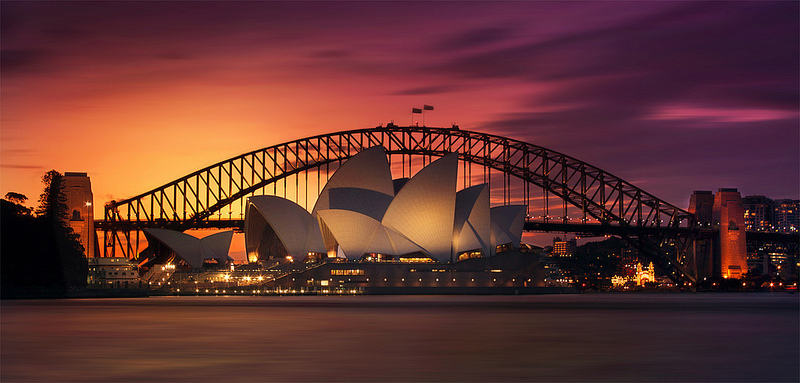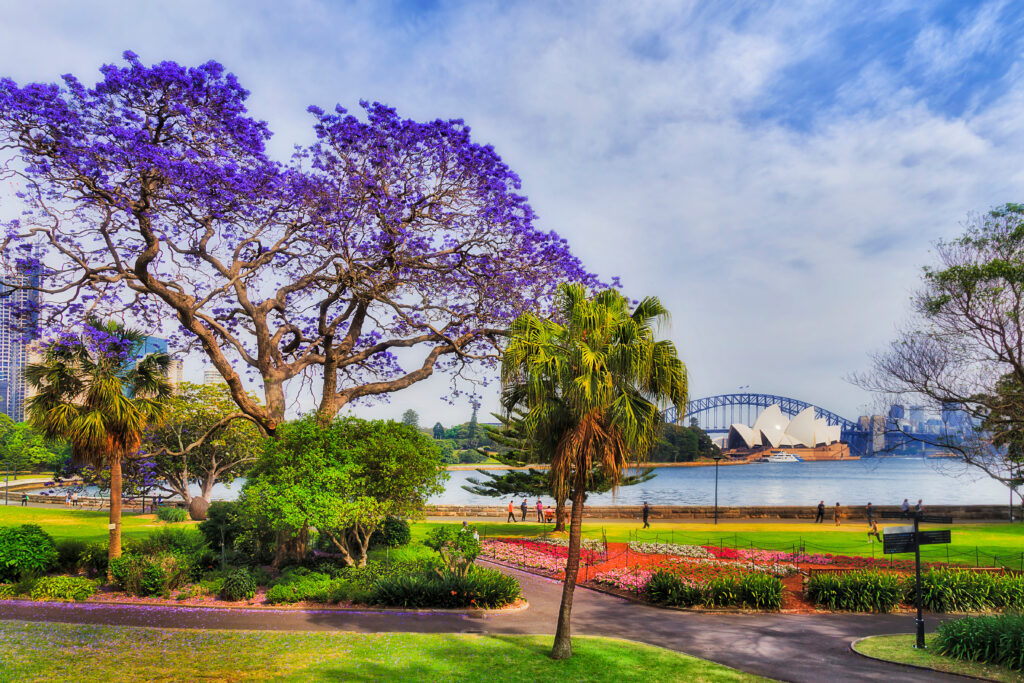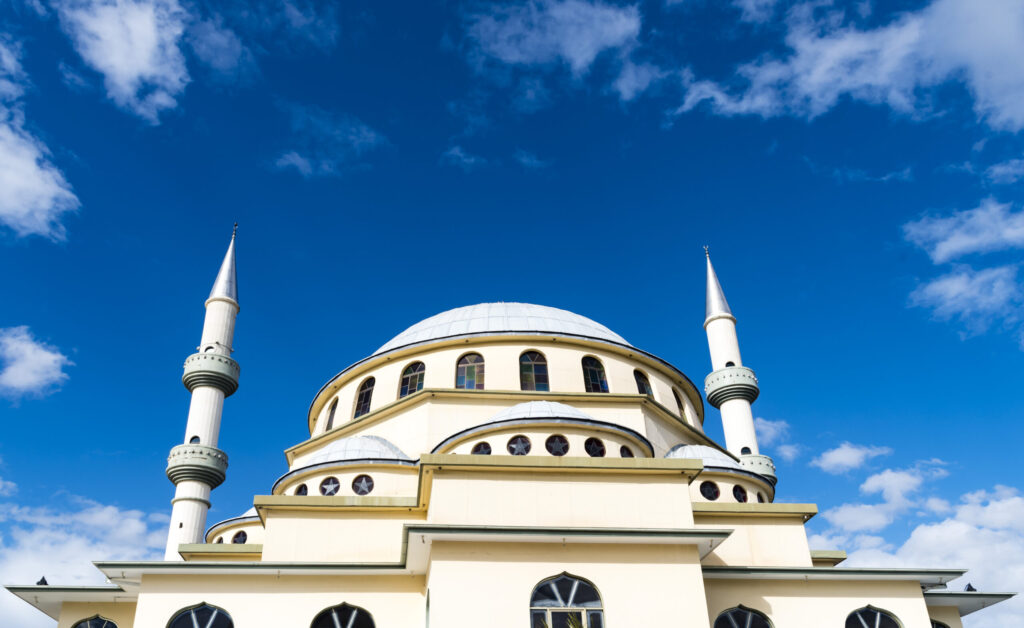Skirting the harbour, Woolloomooloo and the Rocks are some of the oldest and most distinct parts of Sydney. From the rough stone buildings to the weathered timber piers and the dark depths of the harbour itself – if it weren’t for the crowds, you might feel like you’ve stepped back in time a couple of hundred years. The sense of history around here is one of Sydney’s greatest charms, as is the wide range of things to experience.
Highlights
The Art Gallery of NSW is not only free but essential viewing. Post-war Australian artists like Margaret Preston and Grace Cossington Smith are highlights of the permanent collection, painting the harbour foreshore as it once was. There is an extensive collection of Aboriginal art, including bark paintings, sculptures, and weaving, as well as a range of contemporary pieces.
For a history lesson while enjoying a meal or pint then check out Fortune of War, Sydney’s oldest pub. The world may have changed around it, but it has managed to retain its old-fashioned charm. In the same building is the more modern The Push, grab some of their small plates and a cocktail. For cyclists, BarCycle Café is a must visit. It is designed to perfectly suit cyclists and serves up meals for before or after a ride.
Walking around to the other side of The Domain is a must for anyone new to Sydney. Rounding the edge of the park you come to the view of Sydney you’ve been waiting for – across the Botanic Gardens and the harbour to the Sydney Opera House and the Sydney Harbour Bridge behind it. It’s amazing both day and night, no matter what time of year. You get a feel for this special part of the world, and a bit of quiet and space to take it all in.
Around the harbour to the Rocks, you’ll feel the pace pick up a bit. Or a lot. This is the heart of tourism in Sydney and between the view, the crowds, the shops, and the narrow streets, you’re guaranteed to have a good time of it. Past Circular Quay and behind the Museum of Contemporary Art is where the Rocks, known as the oldest suburb in Sydney, officially start. The buildings are quaint and well-worn, and it’s best to visit on a weekend when the markets are in full swing.
Cheap cheats
Circular Quay is nestled in beside the Rocks. Not only are you happily situated between the Opera House and the Harbour Bridge, but you also have boundless opportunities to explore everywhere else. Catching a ferry is easily the best way to see Sydney, and one of the cheapest.
An Opal card will get you to Watson’s Bay for fish and chips, to Millers Point for Luna Park, or as far as Manly, cruising past North and South Head where Sydney Harbour begins.
The Museum of Contemporary Art (known as the MCA) has been a favourite part of The Rocks for many years. The original building was constructed in the 1950s but didn’t open as a gallery until
1991. Since then, it has been home to all kinds of touring exhibitions and installations and hosts a large portion of the Biennale of Sydney when it’s on. In 2012, the building officially reopened with a new wing and almost double the space. Whether you’re here for a free exhibition, or you want a coffee with a view at the upstairs bar, it’s a phenomenal spot to pass the day.
Useful Info
Accommodation
Known for beautiful waterfront views and high rental costs, living by the water is a luxury only few can afford.
We recommend heading a few streets in from the water, and try and find an old terrace house or apartment block. You should be able to find a room in a share house for between $300-$500.
If you want to live by yourself, head a few streets back from the water for single bedroom units between $400-$600 a week.
Community facilities
The library at Customs House is part of the City of Sydney Library Network. Spread across three levels of this beautiful old building; there is a range of quiet reading areas and comfortable lounge chairs to pass the time. You wouldn’t feel like you were in the heart of Circular Quay with all the peace and quiet. And with the largest range of national and international newspapers of any Australian public library, you can catch up on the news from home, wherever that might be. The library is open every day, except for public holidays.
KGV (King George V) is the council-run fitness centre on Cumberland Street in the Rocks. You’ll find all the standard gym facilities under the shadow of the Harbour Bridge, and the space also offers casual basketball leagues, yoga and cycle classes.
Rushcutters Bay is a quieter side of the harbour and has a beautiful park and sporting facilities by the marina. The tennis courts have competitive leagues and casual hire times that should suit both seasoned professionals and those just looking for a fun hit around.
Pricing
Don’t expect a day out in The Rocks to come cheap. You’ll pay almost double for a beer here than you would in the suburbs. The Opera Bar (underneath the Opera House) is on the pricey side, but if you’re going to pay, this is the place to do it. The view is second to none, and they have an excellent wine list and tasting menu, so you can get away with snacks and shared plates if you’re on a budget.
Local legends
Swimming at the Andrew Charlton Pool
The harbour at Woolloomooloo is pretty special, but not quite suited to swimming. So it’s great that the Andrew (Boy) Charlton Pool is located on the foreshore so you get the next best thing. The pool is open between September and May each year and is the best spot in the city to cool off, swim laps, or just enjoy the sun on the deck. You couldn’t get any closer to the harbour without actually being in it.
The Andrew (Boy) Charlton Pool
1C Mrs Macquaries Road, Sydney
A drink at The Glenmore
The Glenmore Hotel was built in 1921 and has been an Australian icon ever since. The range of beers and stunning view from the roof garden are hard to beat. It’s a busy pub that still manages to feel like a friendly local, serving classic pub meals and occasional whisky and boutique beer tastings.
96 Cumberland Street, The Rocks
Background
The Rocks and Bennelong Point (where the Opera House sits now) is the traditional home of the Gadigal people, part of the Darug Nation. The place was significant to the Aboriginal people both spiritually, and because of the location and transport of the harbour.
Following settlement in the 1780s, the region expanded, and early buildings like the Sydney Observatory (constructed in 1858) are a stunning example of Australian history still operating today.





